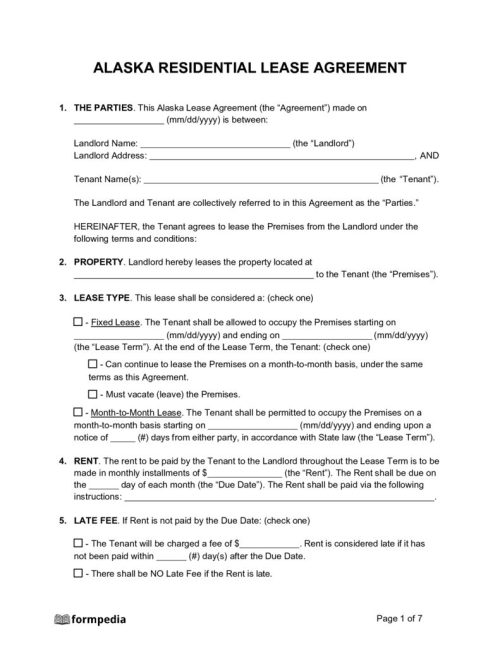An Alaska rental lease agreement is a legally enforceable contract between a landlord and a tenant. This document delineates the specific terms and conditions associated with the rental property, such as the duration of the lease, the agreed-upon rent amount, and the respective responsibilities of both parties involved. It’s crucial to note that Alaska law mandates landlords to provide certain disclosures to tenants, including the potential presence of lead-based paint for properties built before 1978.
Lease Agreements: By Type (6)
Commercial Lease Agreement
A contract for business property rental in Alaska, offering more negotiation flexibility.
Download: PDF, Word (.docx), OpenDocument
Rent-to-Own Agreement (Lease Option)
Allows tenants in Alaska to rent with an option to buy, requiring specific purchase terms.
Download: PDF, Word (.docx), OpenDocument
Month-to-Month Lease Agreement
A flexible lease in Alaska that renews monthly, terminable with a 30-day notice.
Download: PDF, Word (.docx), OpenDocument
Roommate Agreement
A contract between co-tenants in Alaska, outlining individual responsibilities.
Download: PDF, Word (.docx), OpenDocument
Standard (1-year) Lease Agreement
This is a prevalent type of lease in Alaska that lasts for a fixed one-year term. Any changes to the rent or other lease terms can't be made until the lease period ends, unless the lease itself provides for such changes.
Download: PDF, Word (.docx), OpenDocument
Sublease Agreement
Allows tenants in Alaska to rent their leased property to a third party, with original lease terms still applicable.
Download: PDF, Word (.docx), OpenDocument
Landlord and Tenant Act, Simplified
The guidelines and requirements for rental lease agreements are governed by the Alaska Statutes Title 34. This Act provides a detailed framework for understanding the various aspects of a rental agreement. Each section of the Act is designed to offer a comprehensive breakdown of the rules and obligations that landlords and tenants must adhere to.
Required Disclosures (AS 34.03.080):
Landlords or authorized individuals must provide certain information to tenants before the commencement of the tenancy.
Landlord and Manager Information: The landlord must disclose the names and addresses of the property manager and the property owner. This ensures that the tenant knows who to contact for any issues or notices related to the property.
Lead-Based Paint Disclosure: For properties built before 1978, federal law requires landlords to provide tenants with a Lead-Based Paint Disclosure. This informs tenants about the potential presence of lead-based paint, which can be harmful if disturbed.
Rent Guidelines (AS 34.03.020):
The rental agreement can include various clauses and conditions, including the rent amount, as long as they are not prohibited by law.
Rent Amount and Payment: The rental agreement should clearly state the rent amount and when it is due. If no specific agreement is in place, the tenant is expected to pay the fair rental value for the use and occupancy of the dwelling unit.
Security Deposit Guidelines (AS 34.03.070):
Landlords are restricted in the amount they can demand or receive as a security deposit or prepaid rent.
Deposit Limit: A landlord cannot demand a security deposit that exceeds two months’ rent, unless the monthly rent is over $2,000.
Use of Deposit: Upon termination of the tenancy, the landlord can apply this deposit to any accrued rent or damages caused by the tenant’s noncompliance with the rental agreement.
Prohibited Provisions in Rental Agreements (AS 34.03.040):
Certain provisions are prohibited in rental agreements, including those that waive rights or remedies under this chapter.
Waiving Rights: A rental agreement cannot include a provision that requires the tenant to waive any rights or remedies under this chapter.
Liability Limitation and Attorney Fees: The agreement cannot limit any liability of the landlord or tenant arising under the law or require the tenant to pay the landlord’s attorney fees.
Frequently Asked Questions
- What are the rules for rent increase in Alaska?
- What are the landlord's responsibilities for property maintenance in Alaska?
- What are the rules for subleasing in Alaska?
- What are the guidelines for a landlord to enter a tenant's property in Alaska?
What are the rules for rent increase in Alaska?
The Alaska Statutes do not specify a particular notice period for rent increases in periodic tenancies (like month-to-month leases). However, it’s generally recommended that landlords provide at least a 30-day notice for changes in rent.
What are the landlord's responsibilities for property maintenance in Alaska?
Landlords in Alaska are required to maintain the premises in a fit and habitable condition. This includes complying with all applicable building and housing codes affecting health and safety, making all repairs necessary to keep the premises in a fit and habitable condition, and keeping all common areas clean and safe.
What are the rules for subleasing in Alaska?
According to AS 34.03.060, unless otherwise agreed in writing, the tenant may not sublet the premises or assign the rental agreement to another without the landlord’s consent. The landlord’s consent may be withheld only upon reasonable grounds specified in the statute.
What are the guidelines for a landlord to enter a tenant's property in Alaska?
In Alaska, according to AS 34.03.140, a landlord may enter the premises only after giving the tenant at least 24 hours notice, and only at reasonable times. The landlord may enter without consent of the tenant only in case of emergency or if it is impractical to give notice.






